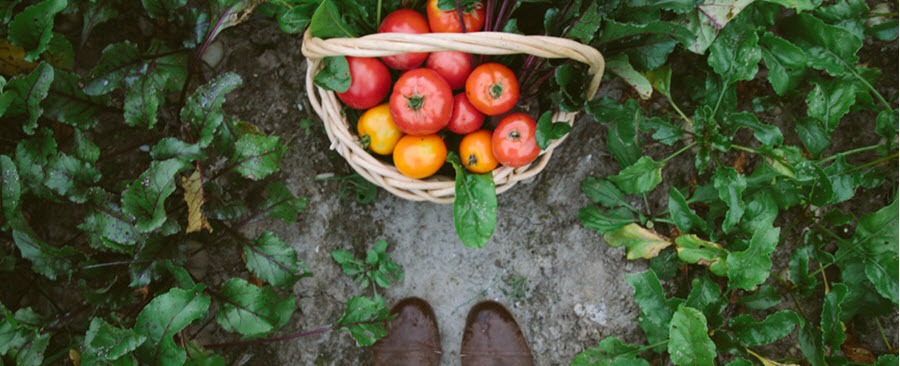Is Buying Local Always the Best Strategy?
Written by Bonny Reichert
Published on April 8, 2017
minute read
Share:
The appeal is clear. Cooking (and eating!) a meal prepared only with ingredients from within a 200-mile radius feels virtuous and community-minded, and the promise of freshness is hard to resist. These were the thoughts that launched my 200-mile dinner quest. The plan seemed ambitious, but manageable. I would gather ingredients from farmers' markets and shops specializing in local produce, which for me means Ontario-grown. I would plan carefully and substitute foods that came from foreign shores. And I'd delight my lucky guests with an all-local extravaganza. After careful planning and research, the menu seemed like a masterpiece:
Appetizer: Owen Sound, Ontario smoked whitefish in a salad with celery, apples, hydroponic lettuce and a cider vinaigrette
Main course: Beautiful striploin steaks from Grey County, served with a scorched tomato butter and chopped fresh herbs
Sides: It was springtime, so local asparagus, roasted potatoes and wilted spinach with shaved garlic chips would be perfect
Dessert: Rhubarb fool with whipped cream, maple syrup and a crushed sugar-cookie topping
At first, hunting and gathering went well. I got to the Saturday market before the smoked fish sold out, picking up fresh herbs and asparagus at the same time. The steaks were easily sourced from my favourite butcher shop, and potatoes and apples were on tap at my local grocery store, as they generally are throughout the year.
But once I started to cook, I ran into some issues. My go-to salad oil is extra virgin olive oil, but since we don't have many olive groves nearby, I had to substitute. I went with canola, which is Canadian, but not quite local for me. The greenhouse cherry tomatoes I bought for the tomato butter were okay, but not nearly as red and aromatic as the ones from Italy that I had to pass over. The most problematic was dessert, because rhubarb, my key ingredient, happened to be out of stock at every single place I looked. That forced me to choose between a replacement of frozen local blueberries or beautiful, fresh, but very non-local, raspberries.
"Some people favour a 'buy local' strategy when creating an investment portfolio."
While my ideal local dinner required some compromises in the end, on reflection I realized this wasn't necessarily a bad thing for me — that raspberry fool was delicious! There's plenty to consider when it comes to local and an investment portfolio. Some people favour a "buy local" or "buy Canadian" strategy when creating an investment portfolio, leading to a preference for home-country companies and products we know, use and feel comfortable with. But just like with a strictly local supper, it can be helpful to think about what investing locally means when it comes to our portfolio mix and what opportunities we may be unaware of further afield.
For example, the Canadian equity market comprised just 3% of the global market in late 2015, according to Morningstar, and it leans heavily on oil and minerals over industries like science and technology. What's more, the world's markets don't necessarily move in tandem because of regional factors like political events, currency fluctuations and individual stock performances.
Opting for a mix of assets from different places in the world or companies that operate globally may be a useful way to diversify. Whether it's groceries or assets, local can work nicely, but depending on your tastes and appetite, hand picking the best from around the world may also be a delicious option.
RBC Direct Investing Inc. and Royal Bank of Canada are separate corporate entities which are affiliated. RBC Direct Investing Inc. is a wholly owned subsidiary of Royal Bank of Canada and is a Member of the Canadian Investment Regulatory Organization and the Canadian Investor Protection Fund. Royal Bank of Canada and certain of its issuers are related to RBC Direct Investing Inc. RBC Direct Investing Inc. does not provide investment advice or recommendations regarding the purchase or sale of any securities. Investors are responsible for their own investment decisions. RBC Direct Investing is a business name used by RBC Direct Investing Inc. ® / ™ Trademark(s) of Royal Bank of Canada. RBC and Royal Bank are registered trademarks of Royal Bank of Canada. Used under licence.
© Royal Bank of Canada 2025.
Any information, opinions or views provided in this document, including hyperlinks to the RBC Direct Investing Inc. website or the websites of its affiliates or third parties, are for your general information only, and are not intended to provide legal, investment, financial, accounting, tax or other professional advice. While information presented is believed to be factual and current, its accuracy is not guaranteed and it should not be regarded as a complete analysis of the subjects discussed. All expressions of opinion reflect the judgment of the author(s) as of the date of publication and are subject to change. No endorsement of any third parties or their advice, opinions, information, products or services is expressly given or implied by RBC Direct Investing Inc. or its affiliates. You should consult with your advisor before taking any action based upon the information contained in this document.
Furthermore, the products, services and securities referred to in this publication are only available in Canada and other jurisdictions where they may be legally offered for sale. Information available on the RBC Direct Investing website is intended for access by residents of Canada only, and should not be accessed from any jurisdiction outside Canada.
Explore More

Should I Invest or Pay Down My Mortgage?
Consider these four questions
minute read

As Many Head Back to the Office, Where Could Investors See Changes?
How returning to in-person work could affect a range of investments
minute read

Considering the FIRE Lifestyle? Here’s What Your Investments Might Look Like
We asked three people how they created financial independence and retired early
minute read
Inspired Investor brings you personal stories, timely information and expert insights to empower your investment decisions. Visit About Us to find out more.







